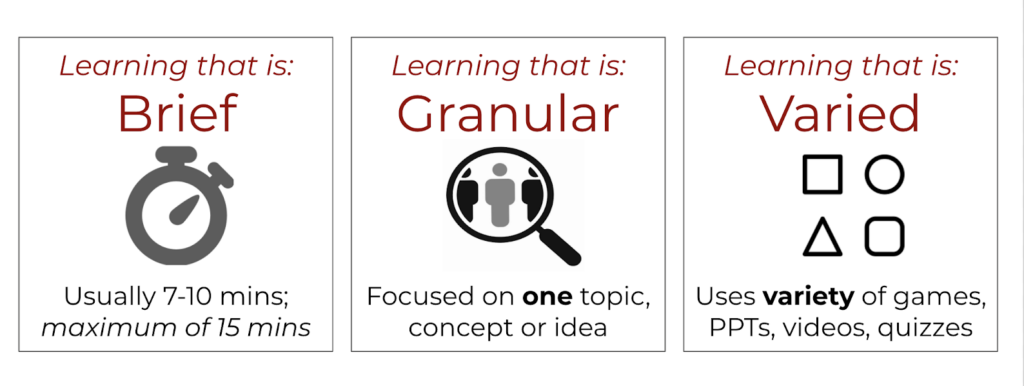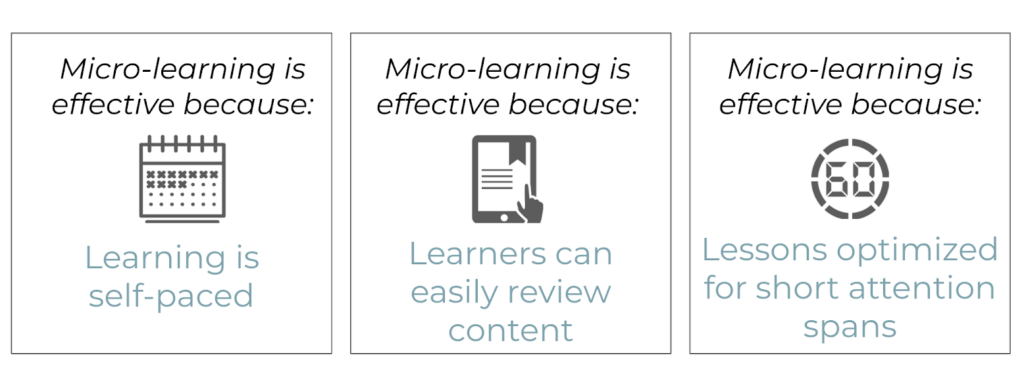What is Microlearning?
Microlearning is a teaching method that targets a single and/or specific learning objective using short, focused modules. In addition to active learning, microlearning increases the speed of knowledge consumption and knowledge retention efficiency. Large chunks of complex information are broken down into manageable units typically administered in a digital or flexible setting. Good microlearning designs offer learners opportunities for practice, feedback, and reflection.
The three primary features of microlearning are:

Why You Should Care About Microlearning
Researchers have found that the average human attention span has fallen significantly due to the rise of smartphones, pointing to the increasing importance of microlearning in any learning system.
Some additional benefits of microlearning include:
- Microlearning can help create a learning culture. Distributing learning over time can ultimately improve employee safety, save companies money, positively impact behavior, and correct attitudes related to the value of training in the workplace.
- Microlearning modules that segment material into highly focused chunks help with knowledge transfer. Well-designed materials can improve processing ability when learning new skills. Such processing is an integral component to building the deep understanding required to apply or transfer learning to new environments.
- Microlearning empowers users by offering control over the timing of and the pace of their learning. Such choice can positively influence one’s motivation to learn, ultimately improving long-term retention.
- Microlearning offers an effective approach to support and maintain retention following an initial learning session. Whether keeping the details of new-to-market drugs top-of-mind or maintaining first responder protocols for inactive personnel, distributing microlearning content can keep users current and produce deeper, more endurable learning.

Proof of Microlearning’s Effectiveness
Microlearning makes learning more efficient and leads to better performance.
- Germany’s Dresden University of Technology studied microlearning and discovered that the method led to 22% better performance and 28% faster completion of material relative to traditional learning approaches.
- Bloomingdale’s leveraged a microlearning platform to improve safety training for 10,000 employees. Ultimately, the program helped the company reduce safety claims by 41% in one year, saving upward of $2.2 million.
- A study of pre-diabetic South Eastern Indian men compared the effect of traditional education intervention (one-day session) compared to a microlearning intervention model. Over two years, the group receiving daily mobile phone notifications encouraging dietary changes and exercise reported a 36% relative risk reduction in developing type 2 diabetes compared to the control group.
- A number of studies have shown that follow-on microlearning support improves the effectiveness of in-person workshops or training sessions. Supplementing in-person content with online spaced practice in the form of short quizzes improves outcomes from continuing medical education (CME) programs. Post-test performance shows a substantial improvement in long-term retention of content in learners who received the spaced microlearning support.
Improving Your Team’s Learning Experience with Microlearning
The addition of microlearning to your teams training regiment can make a huge impact on how efficiently your team absorbs information. A great example of a coach utilizing microlearning is how Coach Seideman instructs his players as the head men’s lacrosse coach at Mount Saint Mary College.
After years of creating and distributing paper playbooks to his team, Coach Seideman realized the playbooks were no good if they were never picked up. This led him to start creating microlearning lessons online through the Learn to Win platform and he noticed a substantial change in how well his players were retaining information.
Coach Seideman said his players liked learning online, and were excited to bring their phones to meetings. By using short lessons and integrating video clips and knowledge checks, players seemed more motivated to dive into their studies. This goes to show how the implementation of microlearning can foster a learning culture in teams as learners are more intrinsically motivated.
Learn more about Coach Seideman’s success with microlearning here.
How Can I Design Microlearning Strategies to Improve How I Learn?
As a learner, the way you study and learn material shapes your long-term retention and understanding of the concepts.
Use these strategies to make your studying easier and more efficient:
- Break your study sessions into chunks rather than cramming the night before an exam
- Group important points by their common topic
- Don’t study only by rereading notes or watching a lecture
- Create questions and interactive activities to force recall
- Study for 15-minute periods organized by topic, and take a short stretch break between periods
Microlearning in Action: Learn to Win Use Cases
- A study at Stanford University aimed to quantify the benefits of teaching with microlearning through Learn to Win. The study broke a group of swimming students into two groups, one using Learn to Win and one not, with the aim to see if those using Learn to Win would score higher on a knowledge check after four weeks. It was found that those who used Learn to Win scored 29% higher than the control group and revealed to the coach which athletes had more effectively grasped the coaching concepts.
- Coach Shanahan of Laguna Beach High School began using Learn to Win to instruct his football players remotely during the COVID-19 pandemic. He noted that the team’s knowledge retention was “dramatically higher than it was in any of the conventional ways we’ve used as a coaching staff”. He says his players enjoy using the app and that the coaching staff is more aware of knowledge gaps than ever before with Learn to Win analytics. Read more about Coach Shanahan’s success using Learn to Win here.
- A top-three pharmaceutical company has partnered with Learn to Win to retool its approach to sales training for new pharmaceuticals. Microlearning activities delivered through the Learn to Win application have replaced content that was previously delivered via ‘tedious’ PDFs and PowerPoints to teach employees to effectively communicate the benefits of a new breakthrough drug to doctors and clinicians.

